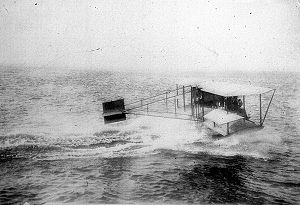Curtiss Model E Video - Picture

|
|
Curtiss Model E
Model E

Picture - The A-1, the United States Navy's first aircraft
Role: Utility aircraft
Manufacturer: Curtiss Aeroplane Company
Designed by: Glenn Curtiss
First flight: 25 February 1911
The Curtiss Model E was an early aircraft developed in the United States in 1911.
History
Essentially a refined and enlarged Model D, variants of the Model E made important steps in pioneering the development of seaplanes and flying boats in that country. Like its predecessor, the Model E was an open-framework biplane with two-bay unstaggered wings of equal span. In landplane configuration, it was fitted with tricycle undercarriage, and as a seaplane with a large central pontoon and outriggers under the wings. Most examples of the Model E followed the pattern of the "headless" Model Ds, with elevators and horizontal stabilizer carried together in the cruciform tail unit. The large ailerons were mounted in the interplane gap, their span continuing past the wings themselves, and were controlled by a shoulder yoke. The Model E was designed and built as a two-seater, although in practice some of the lower-powered versions were converted to single-seaters.
The Model E achieved its greatest fame through examples purchased by the United States Navy. A Model E-8-75 floatplane became the Navy's first aircraft when purchased in June 1911 and received the designation A-1, as well as the nickname "Triad" since it could operate from the land and sea and in the air. Theodore Ellyson became the Navy's first pilot when he took off from Keuka Lake near Hammondsport, New York on 30 June. In all, the Navy was to purchase some 14 Model Es, designating their earliest examples from A-1 to A-4, then redesignating these together with new purchases in the AH-1 to AH-18 block of serials. These aircraft achieved a number of firsts for the Navy, including the first cross-country flight in a seaplane, a world seaplane altitude record of 900 ft (274 m) and a much later national seaplane altitude record of 6,200 ft (1,890 m), and significantly for later naval operations, the first catapult launch of a seaplane.
The aircraft originally designated A-2 had an especially interesting career. Purchased by the Navy in landplane configuration on 13 July 1911, it was converted into a floatplane the following June. In this configuration it set a seaplane flight endurance record of 6 hours 10 minutes on 6 October 1912. Later that month, it was extensively rebuilt along the lines of the Curtiss Tadpole hull, thus becoming the Navy's first flying boat. Later still, retractable wheels were added to create an amphibian that became known as the OWL (standing for "Over Water and Land"). This machine was redesignated E-1 and then AX-1 by the Navy and was finally destroyed on 27 November 1915.
In addition to their naval service, the type was operated by the United States Army, which purchased three examples of the Model E-4 (as Army aircraft numbers 6, 8, and 23), and also acquired one of the Navy's seaplanes (AH-8). Poor safety and reliability records led to all examples being grounded by 1914, although the AH-8 was flown briefly in 1928 following a refurbishment.
An original Model E-8-75 is preserved at the EAA AirVenture Museum and flew as recently as 1984. A replica of the A-1 was built by the San Diego Air & Space Museum and flown a number of times in 1984 before being retired to static display. Another replica was built by the Glenn H. Curtiss Museum and flown in 2004, notable for its use of Curtiss' original flight control system.
Variants
Model E-4 - version with 40 hp (30 kW) four-cylinder engine
Model E-8 - version with 60 hp (45 kW) vee-8 engine
Model E-8-75 - version with 75 hp (56 kW) vee-8 engine
Operators
United States
United States Navy
Specifications (A-1)
General characteristics
Crew: One pilot
Capacity: 1 passenger
Length: 27 ft 8 in (8.43 m)
Wingspan: 37 ft 0 in (11.28 m)
Height: 9 ft 4 in (2.84 m)
Wing area: 331 ft² (30.8 m²)
Empty weight: 975 lb (442 kg)
Gross weight: 1,575 lb (714 kg)
Powerplant: 1 x— Curtiss O, 56 hp (75 kW)
Performance
Maximum speed: 65 mph (105 km/h)
Taylor, Michael J. H. (1989). Jane's Encyclopedia of Aviation. London: Studio Editions. pp. 276-78.
World Aircraft Information Files. London: Bright Star Publishing. pp. File 891 Sheet 42-43.
airventuremuseum.org
aerospacemuseum.org
curtiss-flying-boat
Curtiss Model E Pictures
More aircraft.
Source: WikiPedia